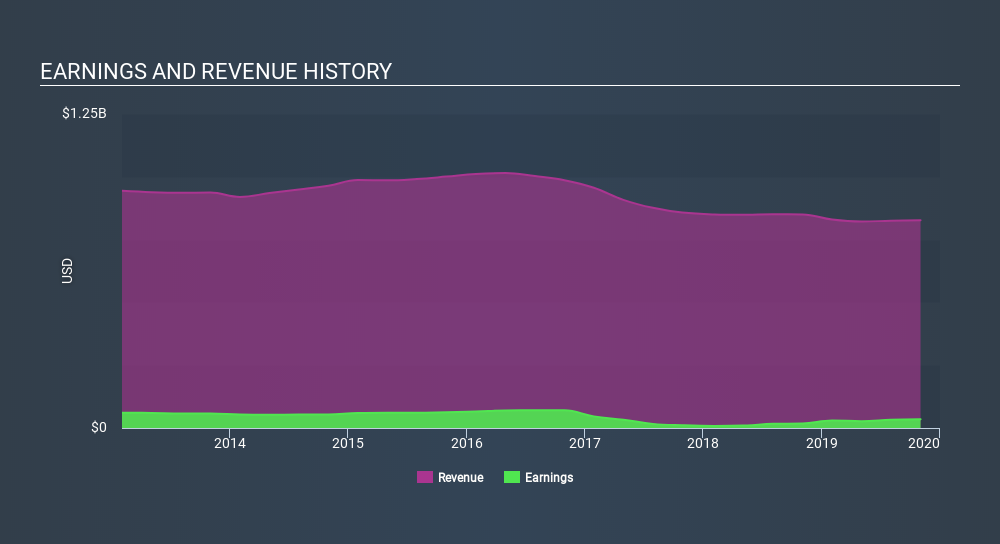- United States
- /
- Specialty Stores
- /
- NYSE:CATO
Are Cato's (NYSE:CATO) Statutory Earnings A Good Guide To Its Underlying Profitability?

Broadly speaking, profitable businesses are less risky than unprofitable ones. However, sometimes companies receive a one-off boost (or reduction) to their profit, and it's not always clear whether statutory profits are a good guide, going forward. Today we'll focus on whether this year's statutory profits are a good guide to understanding Cato (NYSE:CATO).
It's good to see that over the last twelve months Cato made a profit of US$34.6m on revenue of US$826.9m. The chart below shows that both revenue and profit have declined over the last three years.
See our latest analysis for Cato

Of course, it is only sensible to look beyond the statutory profits and question how well those numbers represent the sustainable earnings power of the business. So today we'll look at what Cato's cashflow tells us about the quality of its earnings. Note: we always recommend investors check balance sheet strength. Click here to be taken to our balance sheet analysis of Cato.
Zooming In On Cato's Earnings
Many investors haven't heard of the accrual ratio from cashflow, but it is actually a useful measure of how well a company's profit is backed up by free cash flow (FCF) during a given period. In plain english, this ratio subtracts FCF from net profit, and divides that number by the company's average operating assets over that period. The ratio shows us how much a company's profit exceeds its FCF.
That means a negative accrual ratio is a good thing, because it shows that the company is bringing in more free cash flow than its profit would suggest. While it's not a problem to have a positive accrual ratio, indicating a certain level of non-cash profits, a high accrual ratio is arguably a bad thing, because it indicates paper profits are not matched by cash flow. To quote a 2014 paper by Lewellen and Resutek, "firms with higher accruals tend to be less profitable in the future".
Over the twelve months to November 2019, Cato recorded an accrual ratio of -0.13. Therefore, its statutory earnings were quite a lot less than its free cashflow. Indeed, in the last twelve months it reported free cash flow of US$49m, well over the US$34.6m it reported in profit. Cato's free cash flow improved over the last year, which is generally good to see.
Our Take On Cato's Profit Performance
As we discussed above, Cato has perfectly satisfactory free cash flow relative to profit. Because of this, we think Cato's earnings potential is at least as good as it seems, and maybe even better! And on top of that, its earnings per share have grown at an extremely impressive rate over the last year. Of course, we've only just scratched the surface when it comes to analysing its earnings; one could also consider margins, forecast growth, and return on investment, among other factors. While it's very important to consider the profit and loss statement, you can also learn a lot about a company by looking at its balance sheet. You can seeour latest analysis on Cato's balance sheet health here.
This note has only looked at a single factor that sheds light on the nature of Cato's profit. But there are plenty of other ways to inform your opinion of a company. Some people consider a high return on equity to be a good sign of a quality business. So you may wish to see this free collection of companies boasting high return on equity, or this list of stocks that insiders are buying.
If you spot an error that warrants correction, please contact the editor at editorial-team@simplywallst.com. This article by Simply Wall St is general in nature. It does not constitute a recommendation to buy or sell any stock, and does not take account of your objectives, or your financial situation. Simply Wall St has no position in the stocks mentioned.
We aim to bring you long-term focused research analysis driven by fundamental data. Note that our analysis may not factor in the latest price-sensitive company announcements or qualitative material. Thank you for reading.
About NYSE:CATO
Cato
Operates as a specialty retailer of fashion apparel and accessories primarily in the southeastern United States.
Flawless balance sheet and slightly overvalued.
Similar Companies
Market Insights
Community Narratives



